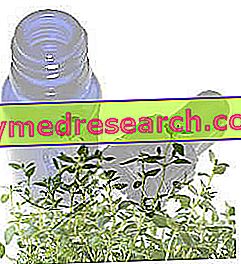
Name: Thymus Vulgaris
Family: Labiatae
Thyme is a plant widely used in cooking to flavor different types of dishes, but it is above all endowed with marked therapeutic activities. It looks like a shrub from 20 to 30 cm high; in Italy it grows almost everywhere in sunny and arid areas.
The thymus: properties
Thyme is known and used since the Middle Ages as a strengthening and restorative, indicated to regularize the menstrual cycle and eliminate various types of parasites, useful for headaches, rheumatic pains, inflammation of the mouth and throat.

Once the essential oil of thyme has been ingested, its components are filtered in the blood through the intestine, then eliminated from the body through the pulmonary alveoli: in this way the active principles act directly on the mucous membranes of the system respiratory.
The most used formulation is the thyme herbal tea, useful against the constriction of the airways; however, the benefits of the thymus are not only located in the respiratory tract, but are also found in the digestive tract reducing the sense of swelling and stimulating digestion.
Thyme also has pain-relieving properties and is used in the formulation of ointments for the treatment of wounds and bruises, also thanks to the intrinsic antiseptic action.
Thyme represents a real natural antibiotic; clinical studies have shown that several pathogenic species are sensitive to this plant; among the sensitive pathogenic bacteria we find the genus Proteus, Staphylococci, Streptococci, Pneumococci, Enterococci, Candida albicans and Corinebacteria.
Essential thyme oils
As mentioned above, in the thymus there are several essential oils, up to 50% of thymol, and to a much lesser extent carvacrol, terpineol, borneol, linalol, geraniol, tujanol; it also contains tannins with antiviral action (3.5-7.5%), flavonoids, saponins and triterpenes with antibiotic activity.
The antibacterial action of the thymus is ascribed mainly to thymol and carvacrol: these essential oils belong to the group of phenols, substances with bactericidal power.
Also linalool and tujanol have important characteristics from a phytotherapeutic point of view: they are fragrant, stimulate the nervous system and have antibacterial properties; they carry out a delicate and non-irritating action, unlike thymol which must therefore be avoided by people with sensitive skin.
Each essential oil is characterized by a chemotype that differentiates its chemical characteristics, consequently the therapeutic ones; therefore, when choosing an essential thyme oil, much attention must be paid to the prevailing chemotype. If the essential oil of thyme is made up of 60% phenols, it is called chemotype thymol; among all, it is the one that develops the most powerful antibacterial action: in case you want to treat infectious diseases it is certainly the most useful, but care must be taken not to apply it pure on the skin or on the mucous membranes (mouth and eyes in particular) because it is very irritating . Attention to those with thyroid problems: this type of oil has a stimulating action on the thyroid gland, even if at normal doses there are no risks, especially if you consume thyme teas.
Oils composed up to 50% tujanol have a strengthening and invigorating effect on the entire body, stimulate the immune system and, very importantly, are not irritating to the skin; the tujanolo has antiviral power, and for this reason it is indicated in cases of bronchitis and flu, and antibiotic, in fact it is effective against Chlamydia, a microorganism responsible for infections of the eyes and genital organs. Unlike the thymotype chemotype, no adverse effects on the thyroid gland have been reported for the tujanol one.
The chemotype linalool contains up to 60% of linalool and exerts formidable antiseptic effects, remaining at the same time delicate and well tolerated by the skin; it is particularly effective against Candida albicans and staphylococci, a group of pathogenic bacteria capable of causing diseases of the skin, intestine, bladder and urogenital tract.
The last important chemotype is the one where the main component is geraniol, well tolerated by the body with a marked action against bacteria, viruses and fungi; in addition to the antiseptic action, this type of oil has calming effects on the nervous system and promotes sleep.
As is often the case, studies conducted on patients have shown that the synergy between the various types of essential oils is much more effective than the administration of a single chemotype.
In addition to the essential oils that are extracted from the thyme, the flowering tops of this plant are also used for pharmacological purposes: the harvest takes place between May and July, when the stems are cut taking care to avoid the woody parts; after drying, they are chopped up and stored in glass or ceramic containers.
Of the thymus are not known interactions with synthetic drugs, despite the increasingly widespread use; the only side effects are due to an excessive use of essential oils: besides the stimulating effects on the thyroid, the ingestion of excessive quantities of essential oil can cause, due to the presence of thymol and carvacrol, gastrointestinal disorders such as nausea, vomiting and headache. In the most extreme and serious cases of intoxication it can lead to depression of the central nervous system.
Recipes and therapeutic indications
Thyme infusion for the respiratory tract
Pour ¼ liter of boiling water onto a tablespoon of dried and shredded thyme.
Leave to infuse for 15 minutes and filter: cover the container with a lid to avoid dispersing essential oils.
In case of cough and bronchitis, up to 5 cups a day can be drunk.
Tablets for sore throat and tonsillitis
We use carbon tablets, essential oil of thymus chemotype linalool and essential oil of thymus chemotype tujanol.
Pour 2 drops of both essential oils over the carbon tablet and let it dissolve slowly in the mouth: repeat 2-3 times a day.



